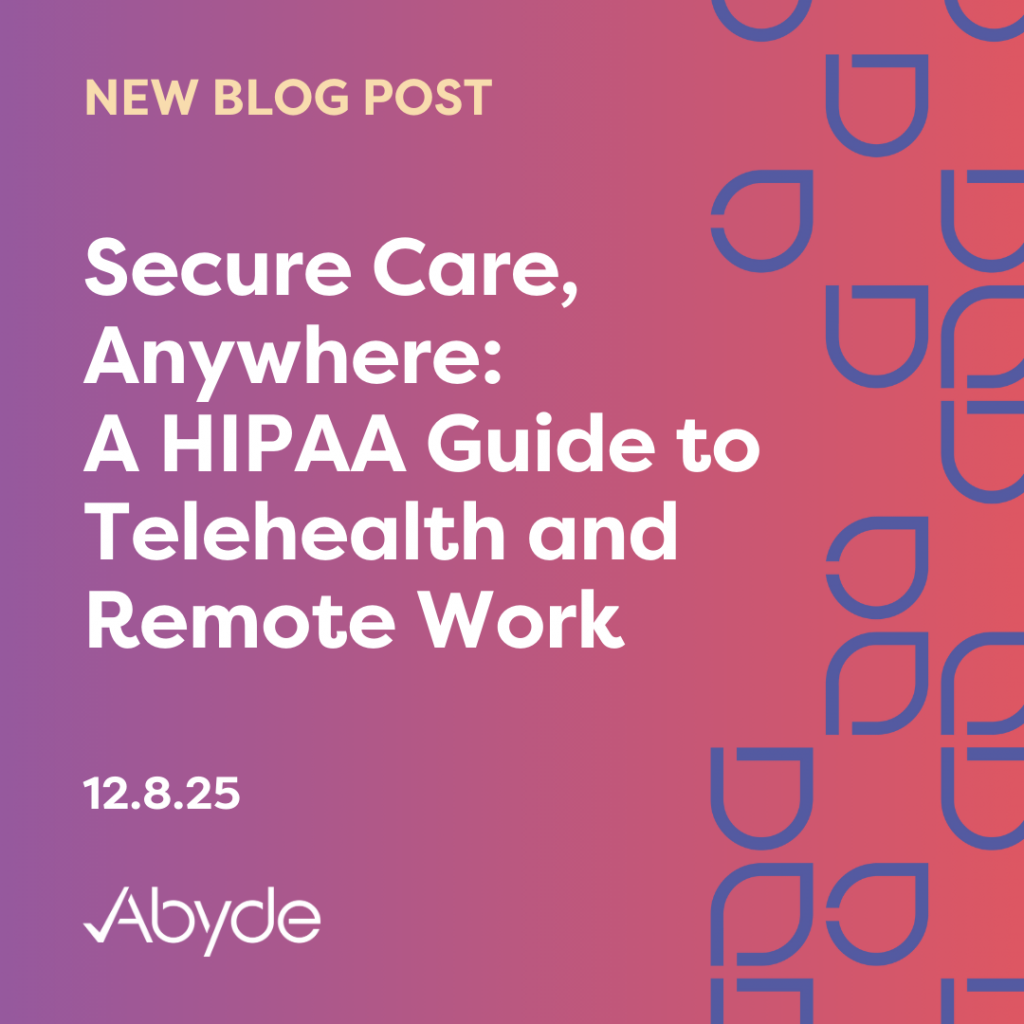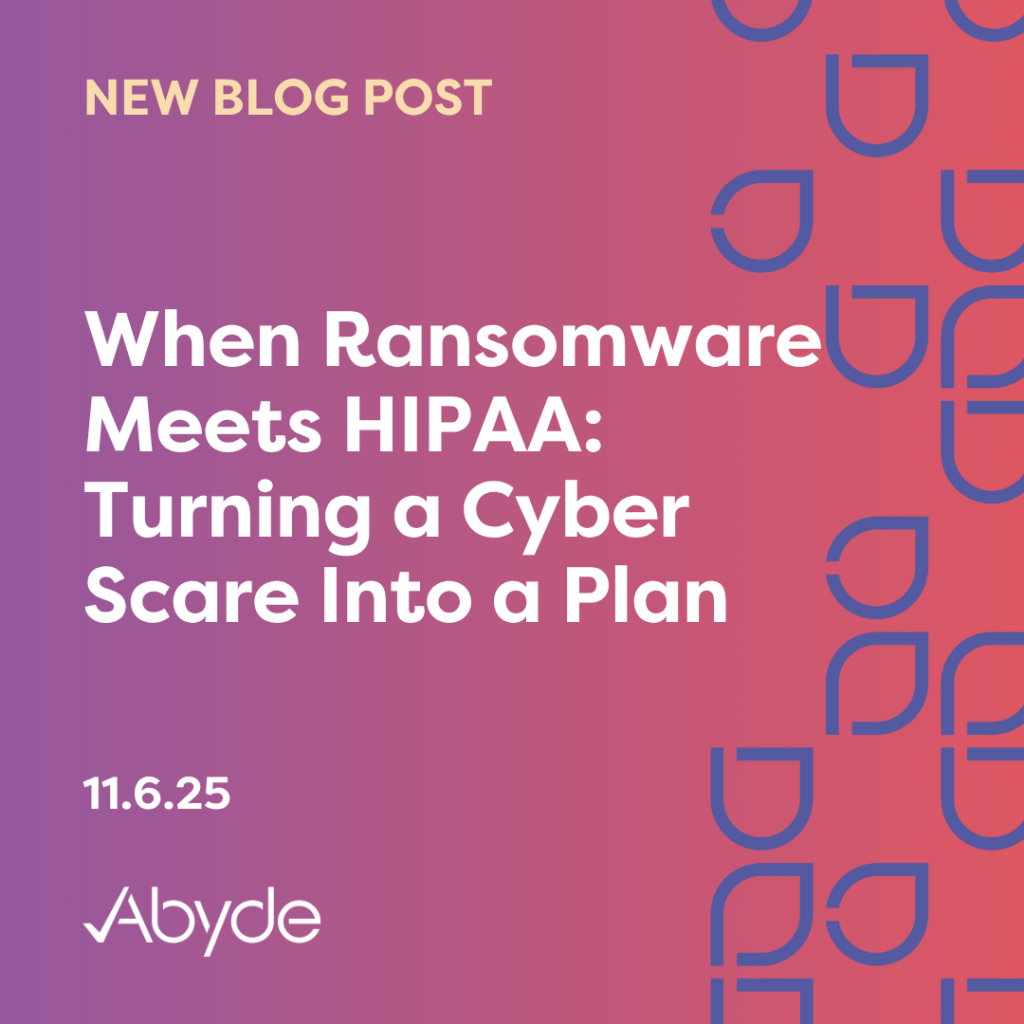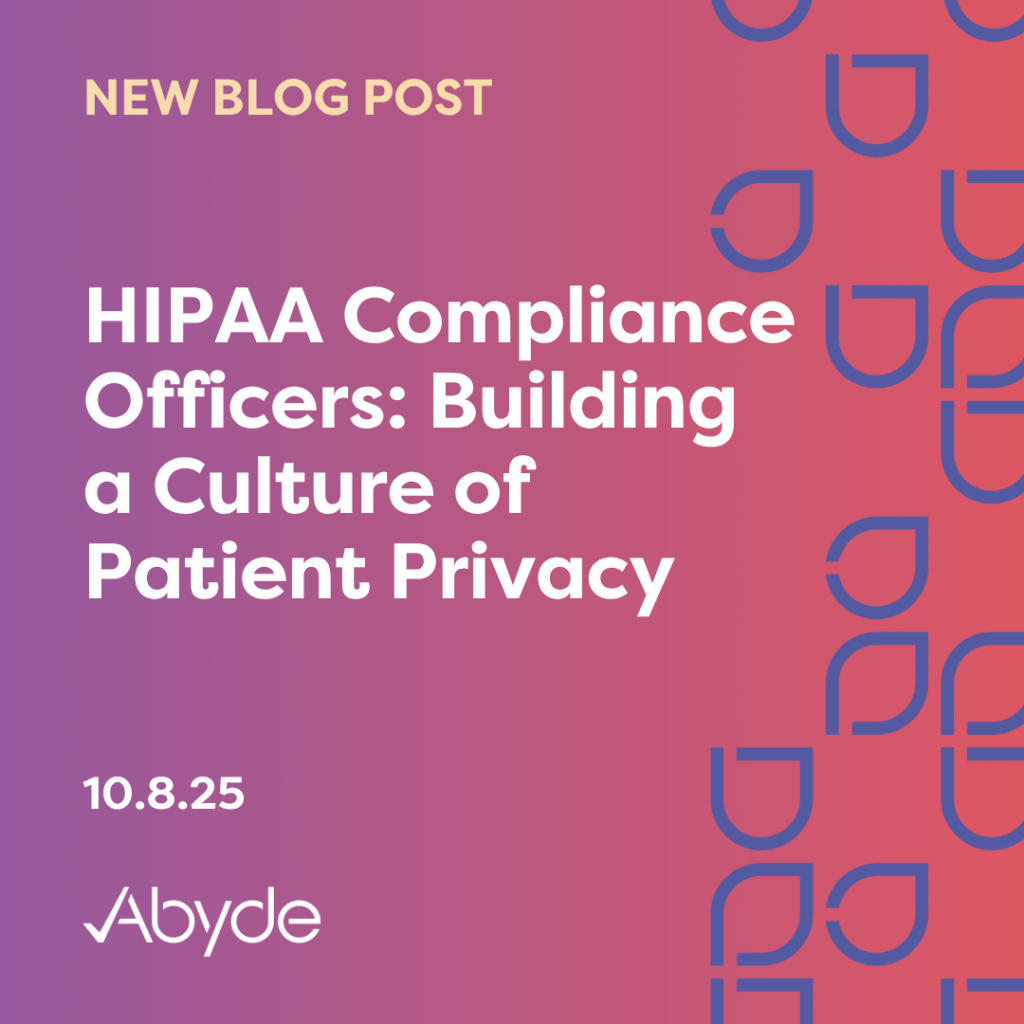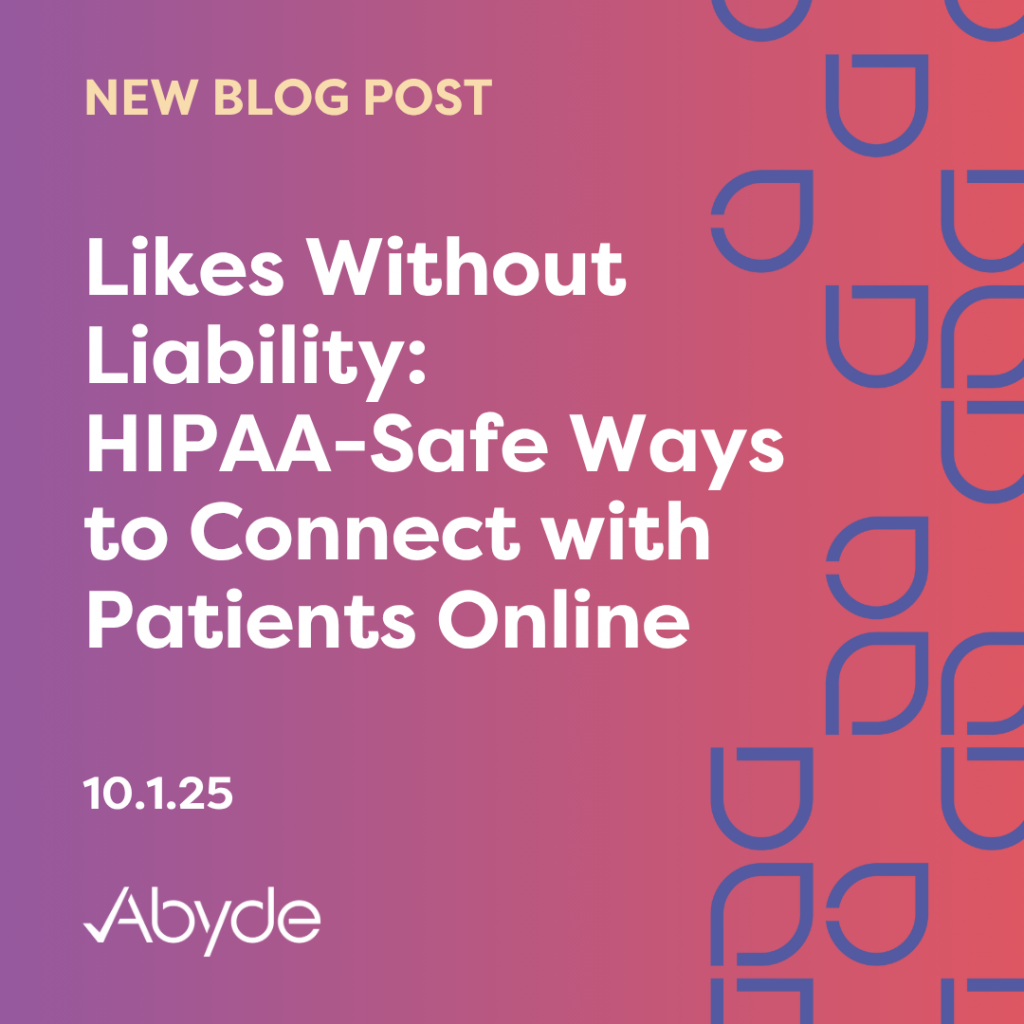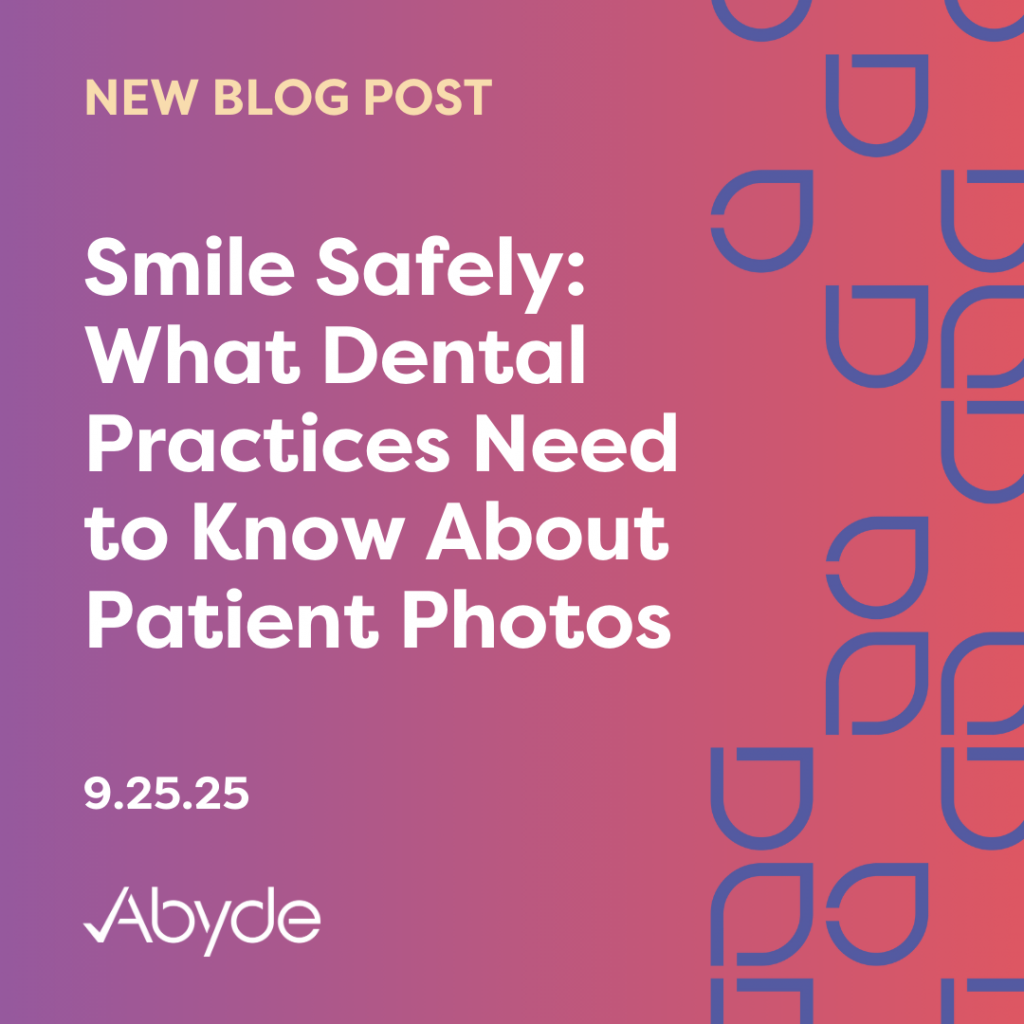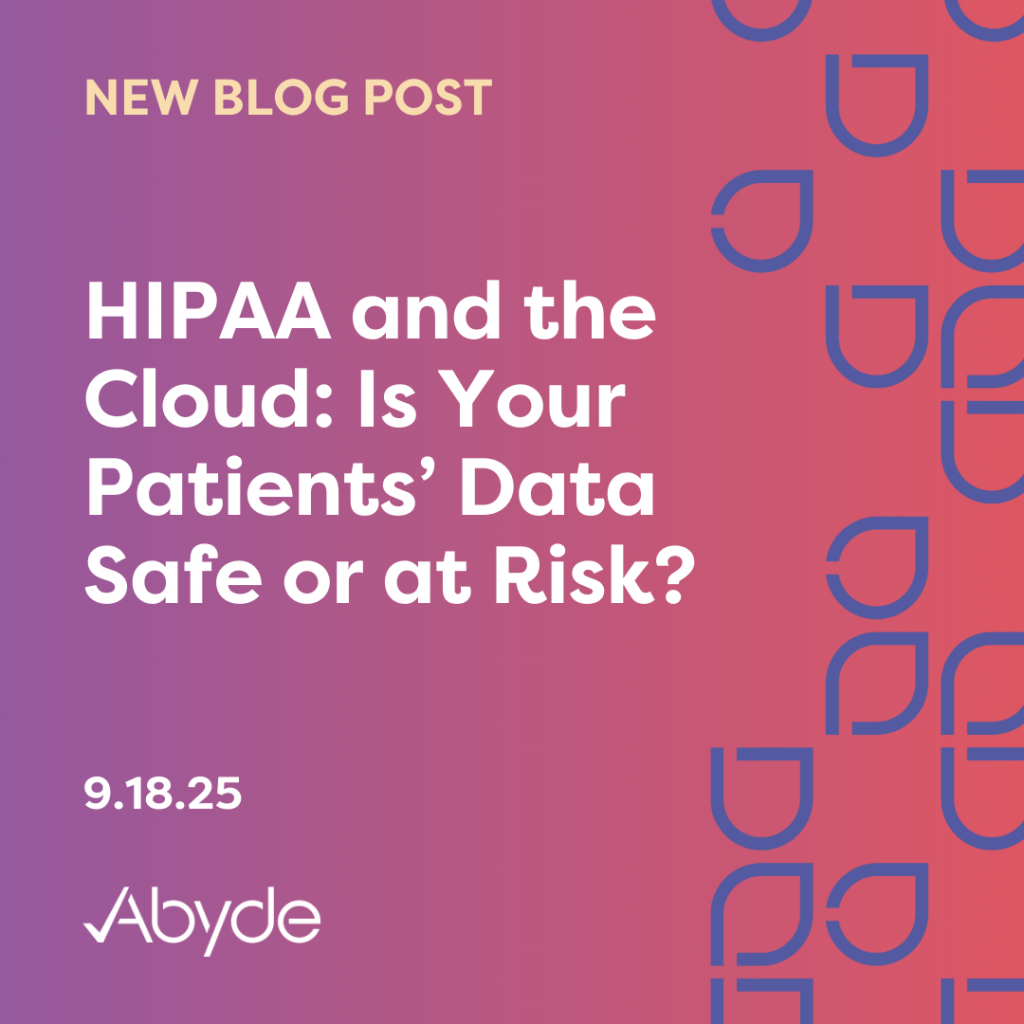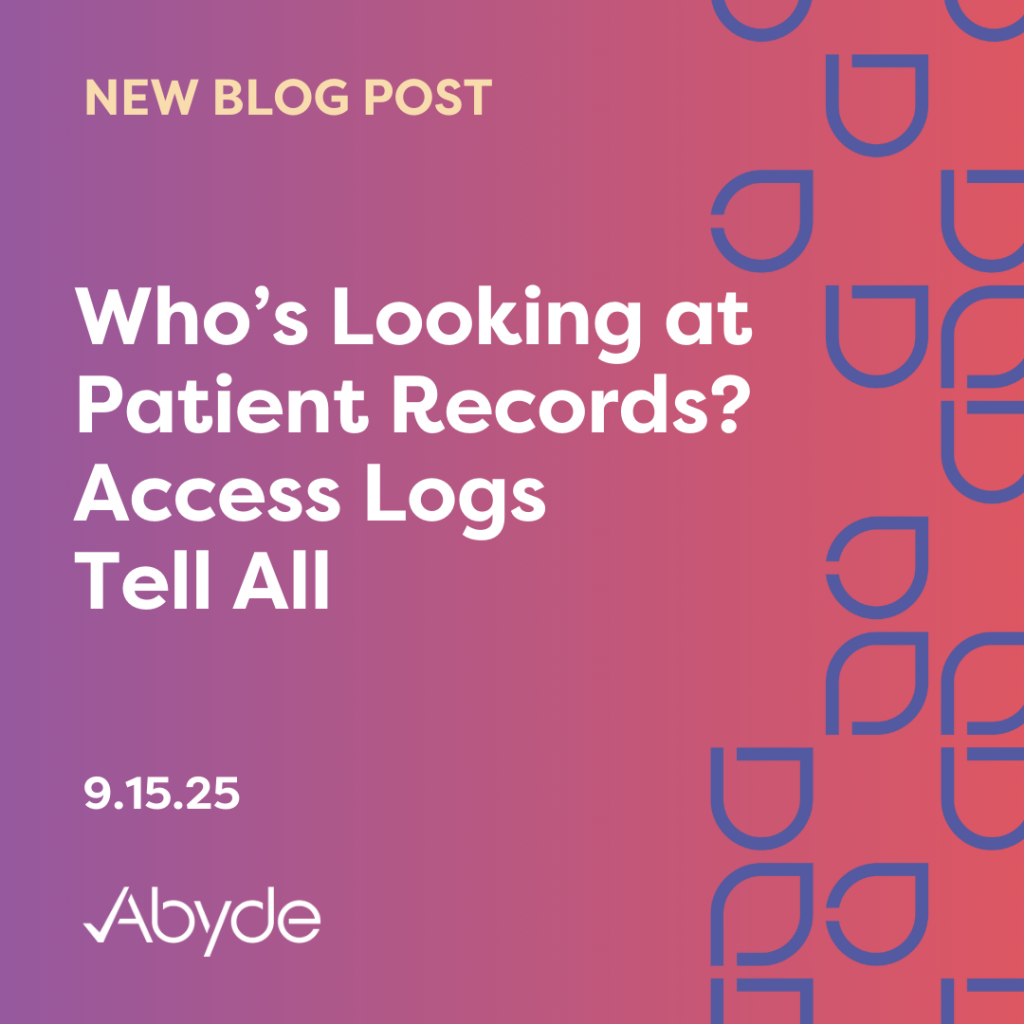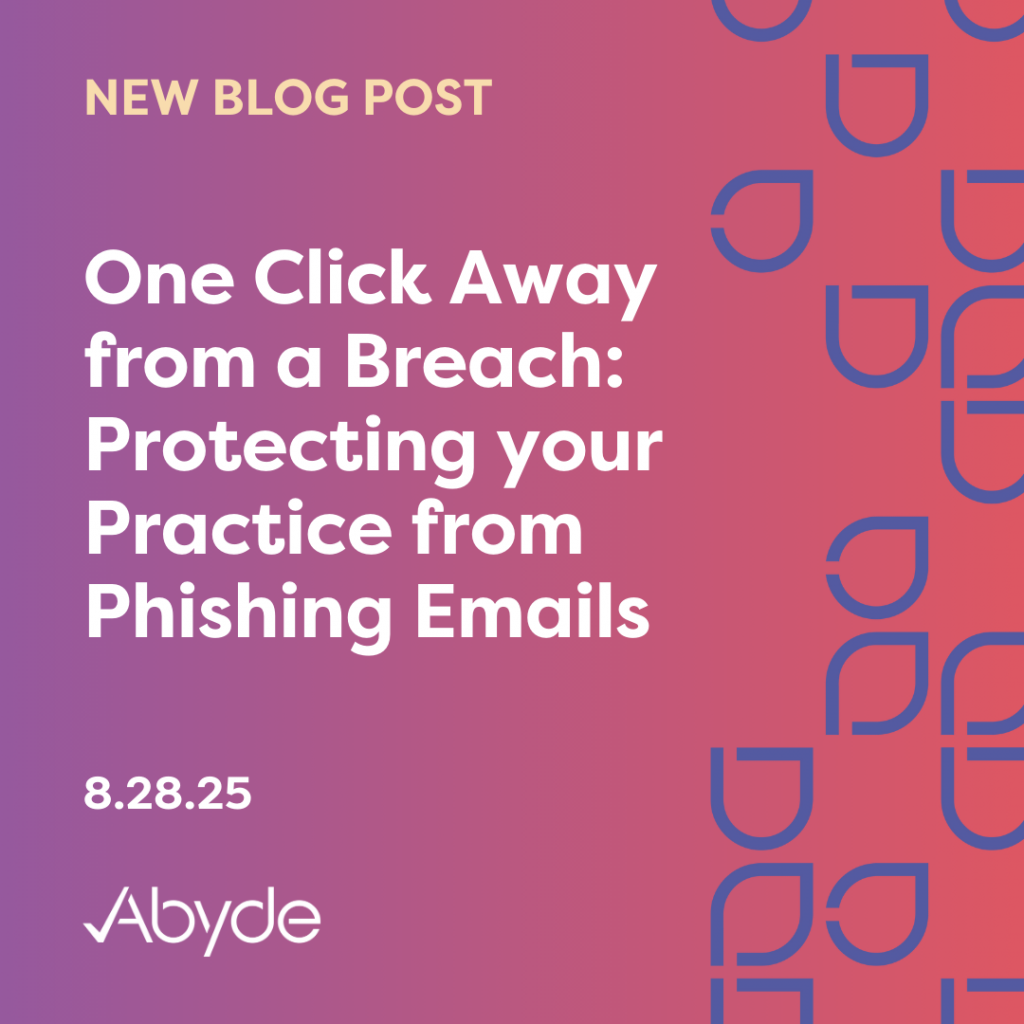December 8, 2025 Nearly six years ago, office staff discovered that work from home was a possible model in the healthcare field. Not only did the work move to the house, but digital, at-home healthcare became wildly popular. If part of your team is still working remotely, whether full-time or part-time, remember: HIPAA isn’t only within the four walls of your organization. Here’s the good news: staying HIPAA compliant from a home office isn’t meant to be complicated. With the right tools and game plan, you can keep Protected Health Information (PHI) secure from the comfort of your own home. Lock It Down at Home Remote work doesn’t change the HIPAA baseline. The standard of “minimum necessary” still applies, safeguards still span people, process, and technology, and documentation still matters. Think of compliance like a thermostat you’ve set correctly: once it’s dialed in, it quietly keeps everything in range. First, your staff needs to understand the standard requirements for keeping data secure and be trained on safely accessing PHI remotely. Do your employees know that it’s a big HIPAA no-no to share sensitive patient data with family during casual conversations while working from home? The best way to communicate what to do is through relevant, documented policies, including a remote work policy. It’s essential that work laptops and any devices with access to PHI are encrypted, and that all logins utilize Multi-Factor Authentication (MFA). Encryption and MFA are both additional layers of protection, ensuring that only authorized users can access PHI. Does staff utilize personal devices for work from home? If so, require mobile device management policies, encryption information, and clear off-boarding procedures. Have a lost-device and incident response policy so your team knows exactly who to notify, how to lock or wipe a lost device, and how you’ll assess whether an event rises to the level of a breach. The work station should also include HIPAA-compliant communication through email and phone calls. If you meet with patients through telehealth services, use an encrypted platform and verify the patient’s identity before each session. As your organization ensures that the proper safeguards are in place, Business Associate Agreements (BAAs) must also be signed for any third parties (encryption services, IT providers, HIPAA-compliant platforms) with access to your PHI. BAAs offset the liability if a breach occurs due to your BA’s negligence. The legal document details exactly what each party is responsible for and how to handle any situation. While the legal aspects might feel overwhelming, they are necessary to keep patient data safe. With clear policies, trained people, and the right security controls, remote work and telehealth can be both convenient and compliant. Remote Ready Remote work and telehealth are no longer temporary fixes to the problem of a pandemic; they’re a simple fact of operating today. HIPAA didn’t change with the scenery, but the right tools can. Intelligent software solutions can provide clear policies, thorough training, compliant BAAs, and more. Telehealth and remote work are here to stay. Keep the safeguards in place, and you’ll be compliant wherever you work, even at home. Meet with a compliance expert to learn more about how your remote organization can achieve HIPAA compliance.
So… OSHA Just Walked In: What Happens Next
November 13, 2025 OSHA doesn’t always call ahead. No heads-up. No appointment. Just, “We’re here. Let’s review your documentation and take a look around.” In fact, half the time OSHA investigates a practice, it’s unannounced. Aside from a random investigation, if anyone in your practice issues a complaint about the work environment or if someone is seriously injured, it’s common for OSHA to conduct an investigation. Take a deep breath! With proactive compliance and an understanding of the investigation process, you can pass with flying colors, keeping your staff safe. What’s an OSHA Investigation? OSHA inspections are routine visits to make sure workplaces are following safety rules. OSHA will target high-risk workplaces, like construction, manufacturing, and, you guessed it, healthcare. When work-related illnesses and injuries in the healthcare industry surpass other fields, it’s no wonder that healthcare is a priority for OSHA. The OSHA official will begin with an opening conference to explain their purpose and the scope of their review. After that, they’ll do a walk-through of your practice and look over your documentation to confirm your safety measures are in place. This can include checking for basics like eye wash stations and accessible fire extinguishers. Your OSHA materials, including risk assessments, SDS library, policies, procedures, and other relevant documents, should be organized and easily accessible to staff. The OSHA investigator can and will also interview staff. Like a pop quiz, your staff must be trained and ready to answer any questions at any time about safety precautions. While being quizzed on OSHA training might not be as fun as being on Jeopardy!, being aware and confident of your practice’s proactive compliance will save your practice from ‘doubling down’ on a massive fine. After a review, a closing conference will be held to review results and next steps. So, what’s after an OSHA Investigation? If everything goes well, hopefully it’s nothing! However, OSHA can and will fine practices found with violations. When the minimum cost of a fine is over a thousand dollars, these violations can quickly add up. In fact, depending on the situation, OSHA fines can cost over $160,000 a violation! Additionally, it can become public record that your practice failed an OSHA audit. OSHA will likely place you on a corrective action plan, ensuring your practice takes the necessary precautions to keep your staff safe. How can I get OSHA Compliant Today? OSHA penalties don’t just sting your budget — they can hurt your reputation, too. But the real reason to stay on top of OSHA isn’t the fine, it’s your people. Protecting your team from preventable injuries and exposures should always come first; avoiding penalties is just the nice side effect. While compliance may feel complicated, it doesn’t have to be that way with the right solution. Smart software can analyze your practice’s compliance standings, offer recommendations, dynamically generate documentation, provide thorough training, and more to ensure your staff is safe every day in your office. Schedule a meeting with a compliance expert to learn more about OSHA compliance in your practice.
When Ransomware Meets HIPAA: Turning a Cyber Scare Into a Plan
November 6, 2025 The lights flicker. Your EHR freezes. A skull-and-crossbones pops up with a countdown, and your team can’t access patient charts. Appointments grind to a halt. No, it’s not a scene from a horror movie you watched on Halloween; it’s what a real ransomware attack can look like for a healthcare practice. Ransomware is a growing threat in healthcare because it goes after what you rely on most: access to patient information. Attackers lock you out of your own systems and demand payment, all while putting Protected Health Information (PHI) at risk. The good news? With the proper safeguards, training, and a plan in place, your practice can respond quickly and minimize the damage. What is a Ransomware Attack? Ransomware is malicious software, or malware, that deliberately seizes records in exchange for a payment, usually demanding enormous amounts of money. The Change Healthcare Breach, the most significant HIPAA breach on record, highlighted the devastating scale of these attacks. This single incident impacted nearly 200 million Americans! It involved a $22 million bitcoin ransom paid to the hackers after the initial attack, as well as billions of dollars in downtime and recovery. That’s how serious these incidents can get. When PHI is worth 10 to 20 times more than a credit card on the black market, it puts healthcare providers in the crosshairs of malicious bad actors. A credit card is like having a single slice of pizza, and who stops at one? A patient’s PHI gives hackers the whole pie. Instead of cheesy goodness, it’s a compliance nightmare for your practice. Ransomware attacks have increased rapidly in the healthcare sector in recent years, with a 264% rise in large breaches caused by ransomware crimes. The big problem is that these threats are Pandora’s box, incredibly difficult to contain once they’ve begun. How can I stop a Ransomware Attack? You can’t guarantee it will never happen, but you can take the proper steps to minimize risks significantly. First, ensure staff are adequately trained on email safety. We hate to break it to you, but that “Free vacation when you send an Apple gift card!” email is probably too good to be true. Most attacks start with a suspicious email that’s opened by unknowing employees. Ensure staff are aware of common phishing signs and know how to report suspicious activity correctly. Also make sure that all proper technical safeguards, such as firewalls and encryption, are current and fully operational to secure patient data. Implement multi-factor authentication (MFA) for all logins to provide an additional layer of protection. While your password acts as a door, MFA acts as a key, keeping patient PHI secure. No practice is 100% safe, but a solid Disaster Recovery Plan empowers your team to actually know what to do if ransomware hits and gives actionable items like quickly taking the infected device offline and involving your IT team immediately. And if you’ve got good backups in place, you can protect your patients and get your practice back on track much faster! Keeping Your Practice Ransomware Ready Ransomware isn’t just a one-time jump scare; it’s an ongoing risk. But when you combine staff training, up-to-date safeguards, MFA, and a thorough response plan, your practice goes from vulnerable to prepared. The best part? You don’t have to figure it out alone! Smart compliance solutions can help you stay on top of requirements, document your actions, and support you if something does go wrong. Ready to learn more? Meet with a HIPAA compliance expert today
How to Stay HIPAA Compliant When Patients Request Their Medical Records
October 27, 2025 Imagine a scenario that’s played out at your practice a million times: a patient calls and asks for a copy of their medical records. Simple, right? Believe it or not, what seems like a routine request can quickly become a compliance risk if your employees misunderstand timelines, allowable fees, or who’s allowed to access certain information. With over 50 penalties and millions of dollars in fees issued by the Office for Civil Rights due to Right of Access violations, your practice has a responsibility to understand its role when handling patient requests. By acknowledging your practice’s duties and properly training your staff, you can empower your team to deliver documents in a timely manner that still protects sensitive data. Right of Access 101 Right of Access, established in the HIPAA Privacy Rule, gives patients the right to receive their records within 30 days of the initial request. Depending on the state, the number of days your practice has to fulfill requests may even be less. For example, California legislation requires that patient requests be upheld within 15 days. This timeline is strict and can only be extended once for an additional 30 days. So, once you receive a request, it’s go time. Before the staff gathers anything, the first question is, how should these records be sent out? Even if the request comes through a secure portal, your staff must encrypt any Protected Health Information (PHI) sent electronically. Certified mail is recommended for safe and trackable delivery if the patient requests a physical copy. Now, what can you charge to deliver these records? Patients have a right to their health records, and any associated costs must be minimal to remain HIPAA compliant. According to the OCR, a flat fee of $6.50 for all requests for copies of PHI maintained electronically. Additionally, ensure that thorough documentation, like a current HIPAA consent form, is in place if the requester is not the patient themselves. Keeping Your Practice Compliant So, think back to the scenario we mentioned earlier. Only now, you don’t have to stress! Your team is trained and aware of their responsibility to fulfill patients’ requests. Your patients get what they want, and even better, your practice avoids thousands of dollars in fines and reputational damage. Quickly and compliantly addressing patient requests promotes patient satisfaction and can help your practice avoid thousands of dollars in fines and reputational damage. The proper software solution centralizes all documentation, policies, forms, and training related to Right of Access. This cloud-based hub provides easy access for everyone in your practice, giving staff the tools they need to be successful. To learn more about Right of Access in your practice, meet with a compliance expert today.
HIPAA Compliance Officers: Building a Culture of Patient Privacy
October 8, 2025 What happens when a patient calls with a complaint about their medical records? Or when a Business Associate requests access to your data? If you’re unsure, it’s time to meet with your practice’s HIPAA Compliance Officer (HCO). HIPAA requires hiring a compliance officer (HCO), which is key to building a foundation of HIPAA compliance for your practice. More than just a box to check, having an HCO provides structure and clarity for your practice, ensuring that all the proper safeguards are in place to secure patient data. While the HCO title might seem like a simple administrative label, the duties are anything but. This vital oversight ensures that everyone knows their HIPAA responsibilities and that patients’ Protected Health Information (PHI) is kept under lock and key. Behind the Badge: Responsibilities of an HCO An HCO wears many hats when it comes to compliance. From safeguarding PHI to managing vendors, these responsibilities form the backbone of a practice’s HIPAA program. First, the HCO needs to complete a Security Risk Analysis (SRA) for the practice. The SRA is a thorough document detailing all physical, technical, and administrative safeguards to keep PHI safe. The HCO should update it annually, and new legislation has been proposed to define this as a yearly requirement strictly. An SRA can be completed by hiring a third-party consultant, leveraging smart software, or even manually entering the information. HCOs should consider time investment, accuracy, and cost before choosing an approach. The HCO must ensure that every staff member is adequately trained and aware of their responsibilities before interacting with PHI. This includes showing new staff where compliance documents (policies, procedures, forms, etc.) are and equipping staff with thorough training to handle any situation with PHI. Additionally, the HCO must ensure all training and documentation are current and in line with the latest legislation. HCOs must also ensure that any relationship with a vendor is handled correctly and there’s documentation to prove it. The vendors, or Business Associates (BAs), that work alongside healthcare providers and have access to PHI must also be HIPAA compliant. One of the most important documents when working with a BA is the Business Associate Agreement (BAA). This required agreement holds both parties liable and defines their responsibilities. Both BAs and Covered Entities must sign this document before working together. The Office for Civil Rights (OCR) can and has fined practices for missing a BAA after a breach. This is only a brief overview of the many responsibilities HCOs take on. A good HCO establishes a culture of compliance, ensuring that protecting patient information becomes second nature for the entire practice. Streamlining HCO Responsibilities At the end of the day, the HCO is the practice’s go-to authority for HIPAA. From handling patient complaints to addressing staff concerns and representing the practice during an investigation, the HCO is the person everyone turns to. While taking on this role might be overwhelming, intelligent solutions can streamline and assist HCOs to ensure they’re always on top of compliance. You can proactively identify gaps and take control by leveraging the right compliance tools. These tools automate and streamline compliance, allowing HCOs to spend less time buried in paperwork and more time guiding their teams. Meet with a compliance expert today to learn more about HIPAA compliance in your practice.
Likes Without Liability: HIPAA-Safe Ways to Connect with Patients Online
October 1, 2025 Doing a TikTok with a patient might make your practice go viral for all the wrong reasons. In a world of social media, email marketing, and overall digital communication, connecting with your patients online is a no-brainer. However, the moment you step into the world of patient engagement, you run straight into red tape, the Health Insurance Portability and Accountability Act (HIPAA) regulations. While a photo of a patient might not seem like a big deal, your practice needs to safeguard patient data, or Protected Health Information (PHI). Typical forms of PHI include a patient’s name, image, Social Security Number, and health records. The internet provides numerous ways to connect and market to patients; your practice must do this carefully, securely, and compliantly. Social Media Landmines The very nature of social media sites like TikTok, Instagram, and Facebook encourages quick, personal sharing of content. These all directly conflict with the strict privacy requirements HIPAA upholds. The good news is, your practice can post with patients if the proper steps are followed to ensure HIPAA marketing compliance. First, your patient must sign a media consent form if their image is posted. This includes testimonials as well. Even if a patient had a great experience with your practice and wants to share, this documentation must be completed. This form must be specific and written, allowing the patient to withdraw permission easily. A verbal agreement isn’t going to cut it. PHI also can’t be shared when responding to Google or Yelp reviews. And yes, acknowledging that a patient attended your practice is considered PHI. Keep all responses brief and respectful. If a patient had a bad experience at your practice, try to take it offline and provide a secure channel to continue communication. Remember that HIPAA violations are not limited to your official practice accounts. Any of your practice’s staff is bound to HIPAA legislation. So, train and ensure staff know their responsibilities to keep PHI secure. No selfies at work! Safeguarding your Inbox Chances are, you’re sending emails every day in your practice. Let’s make sure your practice is sending emails compliantly. First up: encryption. Patient emails are considered PHI, so ensure all the necessary technical safeguards are in place to protect your inbox. After double-checking that the right patient receives an email, keep it simple and send only the minimum necessary information. A quick appointment reminder doesn’t need someone’s full health record attached. Next, consent matters. Your patients might be fine getting reminders or lab results by email, but that doesn’t mean they want marketing messages about specials at another location. Respecting their preferences keeps their information safe and your practice out of trouble. Make sure your practice documents this consent, and like media consent forms, allow your patients to change their permissions at any time. Posting with Peace of Mind This is just a quick roadmap for using marketing tools and HIPAA marketing compliance in your practice, but if done correctly, social media and email can be powerful ways to connect with your patients. Staying compliant isn’t just about following rules; it helps build trust with your patients, which is far more valuable than any number of Instagram followers. While your IT provider can always offer guidance on technical safeguards, understanding these basics is essential for keeping your practice and patient information safe. Smart, practical solutions can make HIPAA compliance easier for your practice. Connect with a compliance expert today to take the guesswork out of compliance.
Smile Safely: What Dental Practices Need to Know About Patient Photos
September 25, 2025 Smile! Members of your dental practice look at countless images of your patients’ pearly whites daily. However, it can be a major HIPAA violation if your practice doesn’t handle these images carefully. While X-rays of a patient seem anonymous, X-rays and patient medical imaging are considered Protected Health Information (PHI). PHI is health data that can easily be linked to an individual patient. In fact, X-rays also usually include further information, including a patient’s full name and birthday, to ensure they are appropriately assigned and shared with the right patient. The same goes for images of patients’ teeth taken with a traditional camera. HIPAA is about keeping patient information safe, protecting healthcare data, and holding everyone accountable. So, your practice’s job is to keep patient images from curious eyes peeking where they shouldn’t. No Peeking! When handling X-rays and other forms of dental photography, ensure that role-based permissions are correctly assigned. In other words, ensure that whoever has access to these images truly needs access. For example, your receptionist most likely doesn’t need access to a patient’s X-rays, but your head dentist would. Your practice must assign these roles to keep patient data safe and terminate any access once an employee leaves or roles change. A recent HIPAA fine highlights the importance of this, with an $800,000 fine after one patient became aware of improper staff access. Your practice should also routinely monitor access to PHI, ensuring that a) the viewer can view specific patient images and b) it makes sense when and how long they review PHI. For example, your practice’s billing staff doesn’t need to look at a patient’s health records at 3 a.m. Noticing odd access to PHI can let your practice catch issues quickly, like hackers. Smile for the Camera (and get an Autograph!) While it’s vital to keep patients’ medical images, such as X-rays and traditional photos, under lock and key, with the right documentation, you can share these images publicly. Let’s say your practice wants to share a patient’s orthodontic journey with braces on social media with a before-and-after post. Before posting anything, make sure your patient signs a media consent form. These forms should be thorough and documented by your practice. A patient must be able to revoke consent easily at any time. While you have this consent, keeping any images as anonymous as possible is still best practice. You shouldn’t be tagging your patients in social media posts! Smile with Compliance Confidence As they say, a picture is worth a thousand words, and in healthcare, those words are PHI that must stay protected. Dental images play a key role in diagnosing and treating patients, which is why your practice needs to keep this form of PHI secure. With the right compliance solution, your practice can simplify HIPAA by managing everything in one centralized hub. Important documents, like media consent forms, are always easy to access. Connect with a HIPAA expert today to learn how to streamline compliance.
HIPAA and the Cloud: Is Your Patients’ Data Safe or at Risk?
September 18, 2025 Sure, your dog pics and selfies are safe in the cloud… but what about your patients’ data? When technology advances, your practice evolves too. As a healthcare provider, your job is to keep your patients and their data safe. The Health Insurance Portability and Accountability Act (HIPAA) covers protecting this data, especially how it is stored. For example, what if a bad storm floods your practice and ruins an internal server? With cloud storage, this isn’t an issue. Cloud storage is hosted elsewhere and accessed through an internet connection, keeping your practice’s Protected Health Information (PHI) safe. Cloud storage and computing are encouraged, but it’s up to your practice to utilize them compliantly. Best Tips for Using Cloud Storage It’s time to do research before working with any cloud service provider. Some good questions to ask include: Does this organization highlight its HIPAA policy on its site? Is it clear what safeguards they have in place to protect your data? Will they encrypt the PHI? Are the servers where PHI is stored located within the United States? While this is not a HIPAA requirement, it’s considered more secure than other nations. Most importantly, is this cloud service provider aware of the extent of its HIPAA responsibilities? Cloud service providers are considered Business Associates (BAs) under HIPAA. While BAs might not deal with patients directly, they handle patient data and are required to follow HIPAA legislation. Cloud service providers are considered BAs whether or not they have access to the encrypted data. Since they store it, they are considered BAs. BAs must complete a Security Risk Analysis (SRA), train staff, maintain up-to-date documentation, and more, like any healthcare practice. Before working with a BA, it is essential to complete a Business Associate Agreement (BAA). BAAs are legal contracts with BAs that ensure both parties are aware of their responsibilities when handling PHI and define the course of action if a breach occurs. A BA and Covered Entity (or, healthcare practice) must complete a BAA before entering a business relationship. Your practice should also avoid working with BAs who do not want to be held legally responsible for handling PHI. Not having a BAA with your cloud storage provider can get you into hot water with HIPAA. In fact, a university was fined nearly 3 million dollars by the Office for Civil Rights (OCR). The OCR discovered that the BA and the college never signed a BAA after a breach of student health data. Storing PHI Compliantly While choosing the right cloud service provider can be extensive, it will significantly benefit your practice. In fact, 83 percent of small healthcare practices surveyed named cloud-based EHR implementations the most meaningful business decisions they had made in the last few years. By doing your due diligence, working alongside your IT team, completing a BAA, and continuing to ensure the proper safeguards are in place, your patients’ PHI can be stored safely in the cloud. As your practice adopts more innovative data management methods, your HIPAA compliance should keep pace. With the right compliance software, your practice can easily streamline requirements like the BAA. Meet with an expert today to learn more about HIPAA compliance in your practice.
Who’s Looking at Patient Records? Access Logs Tell All
September 15, 2025 In your practice, everyone plays an important role. From receptionists handling schedules to doctors delivering care, ensure every team member knows their role and is empowered to act on it. Role-based privileges, which dictate who has access to what information, are also part of assigning roles in your practice. For example, while your receptionist might have access to a patient’s contact information to confirm an appointment, a doctor would have access to X-rays to assist in treatment plans. Without clear boundaries, your practice risks HIPAA violations. For example, it’s a major compliance breach if Beth from accounting looks at a patient’s sensitive health records. That’s where access logs come into play. HIPAA Access logs are key to ensuring that Protected Health Information (PHI) is kept secure. What is an HIPAA Access Log? As the name suggests, HIPAA access logs account for who, when, and for how long a staff member is utilizing a specific software. Your EHR or EMR will keep a running log when staff access information. Your practice must maintain access logs for six years. That’s why it’s so essential for every staff member to have an individual login when using your practice’s systems. Your practice’s HIPAA Compliance Officer (HCO) must routinely monitor access to PHI. Staff must know their responsibilities and the consequences of exploiting access to health records. The OCR takes these exposures very seriously. Earlier this year, a health organization was fined $800,000 due to unauthorized access to health records. The number of exposed patients? One. The patient became aware of this breach and reported the organization to the OCR. An access log is imperative for monitoring unauthorized third-party access, such as hackers, in addition to ensuring staff follow their role-based responsibilities. Healthcare records can often be compromised, and no one realizes it until it’s too late. Cyberattacks happen to organizations of all sizes. In fact, after the multi-billion-dollar breach, investigators found that hackers had infiltrated Change Healthcare’s systems and gone undetected for over a week. Stay Logged In Clear roles and HIPAA access logs aren’t just paperwork; they’re vital for the success of your practice. Your practice must train and empower staff on their responsibilities and investigate when things seem fishy. It only takes one slip-up, even just one patient’s records, to be exposed by impermissible access and caught in the OCR’s crosshairs. With the right software solution, your practice can streamline training, documentation, and logs within a centralized compliance hub. Smart software gives your team the tools to succeed and makes compliance completely doable. Meet with an expert today to learn more about simplifying HIPAA compliance for your practice.
One Click Away from a Breach: Protecting your Practice from Phishing Emails
August 28, 2025 We’ve all received an email that’s a little too good to be true. Maybe it’s a “Congratulations, you’ve won a free vacation!” message, or a heartfelt request from an “international prince” who just needs your bank details. While these examples may sound obvious, phishing emails today are far more convincing, using logos, sender names, and even tone that mirror trusted organizations. However, healthcare staff have an even bigger target on their backs due to the sensitive nature of Protected Health Information (PHI). Healthcare staff, from the office manager to the doctor, are close to patients’ Social Security Numbers, billing information, and more, all of which are a goldmine for a malicious actor. In light of the most recent $170,000 phishing HIPAA fine, it’s essential to review the best tips for keeping your email and patient data secure. Email Safety 101 When hackers send 3.4 billion phishing emails daily, it’s essential to remain vigilant when reviewing emails. One mistaken click can jeopardize thousands of health records, so always carefully read your emails. While your spam filter might hide some risky emails, phishing has become more advanced, including spoofing staff members and, in general, looking legitimate upon first glance. First, when receiving an email, always think before you click. Does the email look suspicious? Is the grammar odd? Are there unnecessary attachments? Never download any attachments unless you are sure of the sender. A hacker could expose your entire practice to ransomware with one unsafe attachment. All it takes is one click. When receiving an email, always ensure the account looks authentic. A familiar name doesn’t always mean a safe email. Cybercriminals are betting on healthcare staff not knowing the difference between ‘yourboss@email.com’ and ‘y0urboss@email.com’. The internet also provides hackers access to public posts, so even if the profile photo might be of your boss, chances are it isn’t your boss sending you an email demanding personal information. Watch for common red flags. If an email feels unusual, pause before acting, especially with messages marked as “urgent.” Cybercriminals rely on panic to push quick clicks. For example, an email shouting “WARNING: Update your EHR immediately using this link” is likely a scam designed to trick you into handing over access. Delete spam emails or forward them to your phishing IT team (if applicable, likely for larger organizations), and ensure your team is aware of any threats and trained to identify and handle them appropriately. Keeping it Secure Phishing emails aren’t rare; they’re routine. That’s why it’s critical to give your staff the tools they need to safeguard PHI. A strong compliance program goes beyond policies by providing hands-on email safety training, encouraging protections like multi-factor authentication, and connecting your practice with trusted IT resources. Meet with an expert today to learn more about HIPAA compliance and email safety.
